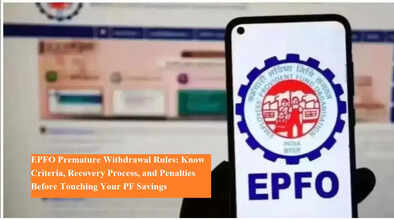EPFO Premature Withdrawal Rules: Know Criteria, Recovery Process, and Penalties Before Touching Your PF Savings

The Employees’ Provident Fund Organisation (EPFO) has issued an important alert for subscribers planning to withdraw money from their Provident Fund (PF) account for reasons not permitted under the scheme. Officials have emphasized that premature withdrawal without valid grounds may lead to recovery action and penalties. Before you dip into your lifelong savings, it is crucial to understand the premature withdrawal rules, eligibility criteria, and recovery process defined by EPFO.
What Does Premature Withdrawal Mean?
A premature withdrawal refers to the process of taking out funds, either partially or fully, from your Employees’ Provident Fund (EPF) account before reaching retirement age.
According to official data, any withdrawal made for purposes outside the list of permitted reasons under the EPF Scheme, 1952 is considered a violation. In such cases, EPFO has the authority to recover the misused funds and impose additional penalties.
Permitted Criteria for Premature Withdrawal
EPFO allows advance withdrawals under specific conditions. Here are the main scenarios where you can withdraw funds legally:
-
For Housing Needs: Members can withdraw up to 90% of their total PF balance to build or purchase a house.
-
For Higher Education: Up to 50% of the accumulated balance from seven years of contributions can be withdrawn to fund children’s education.
-
For Marriage Expenses: Subscribers can withdraw 50% of seven years of accumulated savings for marriage purposes, including for themselves, their children, or siblings.
-
For Medical Emergencies: EPFO permits withdrawal of an amount equivalent to the lower of your PF balance, accumulated interest, or six months’ basic salary plus dearness allowance (DA). This facility is available for medical treatment of self or family members.
-
In Case of Unemployment: If a subscriber remains unemployed for more than three months after losing a job, they can withdraw up to 75% of their PF balance.
These provisions ensure that members have access to funds during critical situations while still protecting retirement savings.
The Recovery Process for Wrongful Withdrawals
EPFO has made it clear that withdrawing funds for reasons not allowed under the scheme can trigger recovery proceedings.
For example, if a subscriber withdraws money citing home construction but later uses it for another purpose, EPFO can take strict action under the EPF Scheme, 1952.
As per Rule 68B(11) of the EPF Scheme, 1952, the following measures apply in case of misuse:
-
The member may be barred from making any further withdrawals for up to three years from the date of the misused withdrawal.
-
The entire misused amount can be recovered by EPFO.
-
Additional interest may be levied as a penalty on the withdrawn amount.
Why You Should Be Cautious
While the option to withdraw funds in emergencies provides relief, misusing this facility could have serious financial and legal consequences. EPFO stresses that PF funds should be treated as long-term retirement savings and used only for purposes explicitly allowed under the scheme.
Financial experts advise members to keep PF withdrawals as a last resort and explore other financing options first. Premature withdrawals not only reduce retirement security but also risk penalties if misused.
Key Takeaway
Before touching your PF account, make sure you fully understand the premature withdrawal rules, eligibility criteria, and EPFO’s recovery process. Using your savings for unauthorized purposes may lead to penalties, loss of future withdrawal rights, and even financial setbacks in retirement.
In short, your Provident Fund is designed to safeguard your future. Handle it with care and follow the rules to avoid unnecessary trouble.

